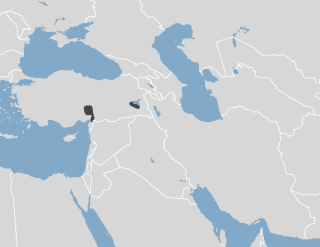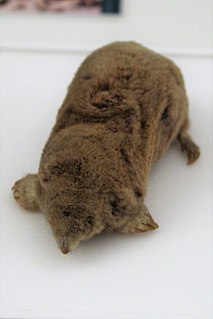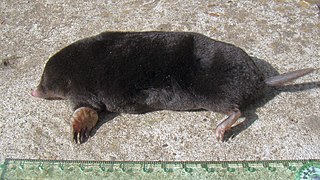
The family Talpidae includes the moles who are small insectivorous mammals of the order Eulipotyphla. Talpids are all digging animals to various degrees: moles are completely subterranean animals; shrew moles and shrew-like moles somewhat less so; and desmans, while basically aquatic, excavate dry sleeping chambers; whilst the quite unique star-nosed mole is equally adept in the water and underground. Talpids are found across the Northern Hemisphere of Eurasia and North America, and range as far south as the montane regions of tropical Southeast Asia.

The European mole is a mammal of the order Eulipotyphla. It is also known as the common mole and the northern mole.

The subfamily Talpinae, sometimes called "Old World moles" or "Old World moles and relatives", is one of three subfamilies of the mole family Talpidae, the others being the Scalopinae, or New World moles, and the Uropsilinae, or shrew-like moles.

Père David's mole is a mole found in the Middle East, ranging from south-central Turkey east to Kurdistan Province, Iran, although it could also range south into Syria. It is listed as a data deficient species. The species is named after the zoologist Armand David. As T. streeti, it is known as the Persian mole.

Talpa is a genus in the mole family Talpidae. Among the first taxa in science, Carolus Linnaeus used the Latin word for "moles", talpa, in his Regnum Animale to refer to the commonly known European form of mole. The group has since been expanded to include 13 extant species, found primarily in Europe and western Asia. The European mole, found throughout most of Europe, is a member of this genus, as are several species restricted to small ranges. One species, Père David's mole, is data deficient. These moles eat earthworms, insects, and other invertebrates found in the soil.

The blind mole, also known as the Mediterranean mole, is a mole found in the Mediterranean region. It is similar to the European mole, differing most prominently in having eyes covered with skin. It is found in Albania, France, Greece, Italy, Monaco, Montenegro, San Marino, Serbia, Slovenia, Switzerland, and Turkey. It is typically carnivorous in nature. Individuals can grow up to 12 cm in length.

The Caucasian mole is a mammal in the family Talpidae that is endemic to the Caucasus Mountains of Russia and Georgia.

The Levant mole is a species of mammal in the family Talpidae. It is found in Armenia, Azerbaijan, Georgia, Russia, and Turkey.

Talpini is a tribe of mammals known as Old World Moles. It is a division of the subfamily Talpinae.

Ognev's mole is a species of mammal in the family Talpidae. It occurs in the southeastern coastal area of the Black Sea from northeastern Turkey to Georgia. It inhabits different habitats associated with moist soils in lowland areas. Little information is available about its life history.

The Talysch mole is a species of mammal in the family Talpidae. It is a small member of the family, which outwardly resembles the Levant mole, but is genetically closer to Père David's mole. It is common on the southwest coast of the Caspian Sea, from southern of Azerbaijan through most of the north of Iran. The habitat includes temperate rainforests and scrub areas. There is little information about the life history of the Talysch mole. It was described in 1945, but had long been considered a subspecies of various other Eurasian moles, and was only recognized as a distinct species in the mid-2010s. No surveys have been carried out to quantify the status of the species.












